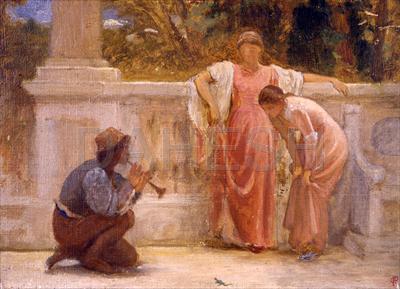Charles Edward Perugini (British, 1839–1918)
Study for The Green Lizard, ca. 1902
Pencil and oil on artist’s board, 6 5/16 x 9 7/8 in.
1997.8

The art critic Marion Spielmann wrote, in 1898, that Perugini was “the painter par excellence of the siesta, the recorder, in delicate color and harmonious line, of the delights of sweet idleness — when life is young and love is warm, ideally gracious, and — more or less platonic…” Written three years before The Green Lizard was made, they perfectly characterize this painting.
This sketch for The Green Lizard — the finished painting was exhibited at the Royal Academy in 1902 (location unknown) — reflects the influence of the prominent British artist Fredric Leighton, for whom Perugini worked as an artist’s model. Like many of Leighton’s paintings, time and place in this work remain indeterminate. Only the vaguely medieval costume of the flute-playing boy and the bright light, the classical column, and the lush greenery in the background indicate when, and where, this scene is set.
The subject of this sketch — an innocent flirtation between two well-to-do girls and a boy who might be a servant — is familiar from any number of genre pictures exhibited at the Royal Academy during the Victorian era. Yet telling a story is perhaps less important to Perugini than conveying an atmosphere of hazy leisure, as in work by his contemporary Albert Moore. Such an atmosphere had a ready appeal for a London audience that longed for the sun and warmth of the Mediterranean.


